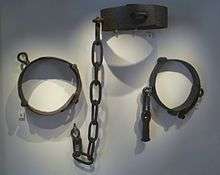Jougs
The jougs, juggs, or joggs (Old French: joug, from Latin jugum, a yoke) is a metal collar formerly used as an instrument of punishment in Scotland, the Netherlands and other countries.

Purpose
The jougs was an iron collar fastened by a short chain to a wall, often of the parish church, or to a tree or mercat cross. The collar was placed round the offender's neck and fastened by a padlock. Time spent in the jougs was intended to shame an offender publicly. Jougs were used for ecclesiastical as well as civil offences. Some surviving examples can still be seen in situ in Scottish towns and villages. Jougs may be the origin of the later slang word "jug", meaning prison.
Examples

Sir Walter Scott rescued the jougs from Threave Castle in the Borders and attached them to the castellated gateway he built at Abbotsford House.[1]
The old Tolbooth museum in Sanquhar in the Nith valley has jougs attached to the wall just outside the entrance to the old gaol.
The jougs at Sorn Kirk were stolen in the 1930s, but located and returned. Cuthbertson refers to the jougs as "symbols of the session's power against gossips and evil-doers".[2][3]
The jougs at Kilallan Kirk near Kilmacolm were stolen and by chance retrieved and donated to the local museum. A story is told of a lady of short stature who was placed in the jougs; however, she fell off the box and was strangled, as the chain was too short for her.[4]
The jougs on the Isle of Cumbrae survive, attached to a gatepost at the entrance to the Millport Old Cemetery entrance.[5]
The "Clachan Oak" is an ancient sessile oak near Balfron in Stirlingshire. It can still be seen bearing metal bands around its trunk to which jougs were once attached for the restraint and humiliation of petty criminals.[6]
Mr. Carse of the Shawhill Estate protected a fine old thorn tree that grew at the Hurlford Bridge end by attaching a pair of jougs to it, made by David Brown the local blacksmith. These were never used, but acted as a deterrent to local children who might have harmed the tree.[7]
Gallery
 Jougs at Oxnam Parish Kirk, Scottish Borders
Jougs at Oxnam Parish Kirk, Scottish Borders Jougs on the perimeter wall of Duddingston Kirk, near Edinburgh
Jougs on the perimeter wall of Duddingston Kirk, near Edinburgh- Jougs at Stobo Kirk, Scottish Borders
 Jougs attached to the tolbooth at Kilmaurs, Ayrshire
Jougs attached to the tolbooth at Kilmaurs, Ayrshire Jougs at Eckford Parish Kirk, Scottish Borders
Jougs at Eckford Parish Kirk, Scottish Borders- Jougs at the entrance to the parish kirk in Abernethy, Perthshire
- Jougs of South Leith Parish Church
 Jougs attached to the tolbooth at Kirkcudbright, Dumfriesshire
Jougs attached to the tolbooth at Kirkcudbright, Dumfriesshire
References
- Napier, George G. (1897). The Home and Haunts of Sir Walter Scott, Bart. James Maclehose, Glasgow. p. 153.
- Cuthbertson, David Cuningham (1945). Autumn in Kyle and the Charm of Cunninghame. London : Jenkins. p. 116
- Sorn Church Retrieved : 2011-01-11
- "Kilallan Kirk". Retrieved 31 January 2018.
- Steele, John and Noreen (2009). Welcome to Wee Cumbrae. Privately published. ISBN 978-0-9532637-0-7. p. 38
- Rodger, Donald, Stokes, Jon, et. al (2006). Heritage Trees of Scotland. The Forestry Commission & The Tree Council. ISBN 0-904853-06-3. p. 182
- Wilson, M. (1875). The Ayrshire Hermit: Tammie Raeburn. Hurlford Sixty Years Ago. Kilmarmnock : Alfred Chas. Jonas. Pages 40 and 41

External links
| Wikimedia Commons has media related to Jougs. |
- Video showing the Kilmaurs Jougs
- Video and narration about the Fenwick Jougs
- Bygone Punishments of Scotland by William Andrews 1899 on electricscotland.